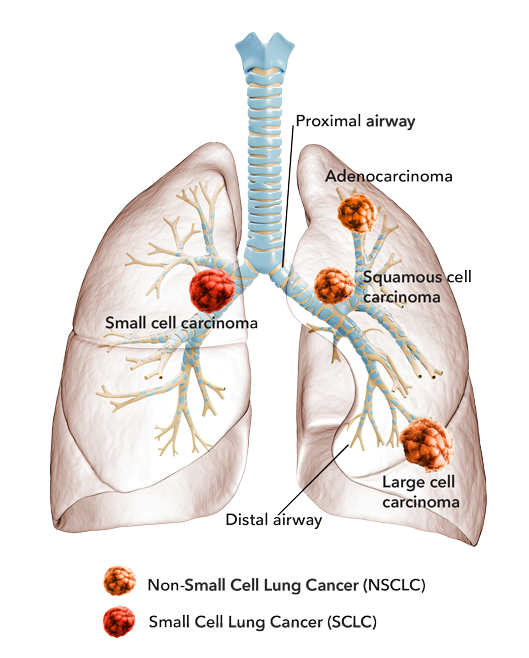Lung Cancer Overview

Lung cancer is the leading cancer killer in both men and women in the U.S.1
Every 4 minutes, someone in the U.S. dies of lung cancer.2
The Significant Unmet Need
LIFETIME DIAGNOSIS RATE
Currently, 1 in 16 people in the U.S. can expect
to receive a lung cancer diagnosis.2,3
LUNG CANCER MORTALITY RATE
Lung cancer kills almost three times as many
women as breast cancer, and almost three times
as many men as prostate cancer.2,3
NO. 1 CANCER KILLER AMONG WOMEN
Lung cancer is the leading cancer killer among women in the U.S.2
NO. 1 CANCER KILLER AMONG WOMEN
Lung cancer is the leading cancer killer among women in the U.S.2,3
DEATHS NATIONWIDE
An estimated 127,070 lung cancer deaths are expected to occur in 2023
in the U.S., accounting for about 1 in 5 of all cancer deaths nationwide.4,5
DEATHS WORLDWIDE
An estimated 1,796,144 lung cancer deaths occurred in 2020 globally, which accounts for about 18% of all cancer deaths worldwide.6
DEATHS PER DAY
Lung cancer kills 382 people each day in the U.S.2
DIAGNOSIS PER DAY
An estimated 238,340 people in the U.S. will be diagnosed with lung cancer in 2023 with a new diagnosis every 2.2 minutes.1,3
NOT ONLY SMOKERS GET LUNG CANCER
In the U.S, people who never smokedaccount for approximately 20% of lung cancer diagnoses each year. An estimated 47,660 non-smokers will be diagnosed with lung cancer in 2023.3
EARLY DIAGNOSIS SURVIVAL RATE
If lung cancer is caught early, before it spreads to the lymph nodes and other organs, the likelihood of surviving 5 years or more improves to 60%.2
LUNG CANCER CARE
Only 6% of federal government dollars spent on cancer research was spent on lung cancer research in 2022.1
Where NSCLC & SCLC Begin7
Forms of Lung Cancer

Non-Small Cell Lung Cancer (NSCLC)5,8
- Accounts for about 80% to 85% of all lung cancer cases
- Larger-sized cells that are typically slower-growing
- Most common types
- Adenocarcinoma (Approx. 40% of NSCLC)Squamous cell carcinoma (Approx. 30% of NSCLC) Large cell carcinoma (10-15% of NSCLC)
- Less aggressive vs. SCLC
- Diagnosed at a later stage
- (Only 25% diagnosed at stage 1 or 2)
Small Cell Lung Cancer (SCLC) 8,9
- Accounts for about 10% to 20% of all lung cancer cases
- Smaller-sized cells that grow and spread quickly
- Starts in the airways (bronchi)
- Poorer prognosis compared to NSCLC, regardless of stage
- The 5-year survival rate in the U.S. is 8% for women and 6% for men
- Around 94% of people with SCLC are diagnosed after the cancer has spread outside the lung
Lung Cancer Risk Factors10,11

- Smoking
- Exposure to second-hand smoke
- Previous radiation therapy
- Exposure to radon gas
- Exposure to asbestos and other carcinogens
- A family history of lung cancer
For all inquiries please contact: medinfo@smmttx.com
References
- Lung Cancer Statistics. LUNGevity (2023). Accessed September 19, 2023
- 29 Lung Cancer Facts You Should Know. Lung Cancer Foundation of America (2022). Accessed October 3, 2023
- Lung Cancer Facts 2023. Lung Cancer Research Foundation (2023). Accessed October 3, 2023
- Non-Small Cell Lung Cancer. National Cancer Institute (2022). Accessed October 3, 2023
- Key Statistics for Lung Cancer. American Cancer Society (2023). (NSCLC cases calculated 238,340 X 0.85). Accessed October 3, 2023
- Global Cancer Incidence and Mortality Rates in 2020. World Health Organization (2022). Accessed October 3, 2023
- Lung cancer is mainly classified as SCLC or NSCLC. ResearchGate (2022). Accessed October 3, 2023
- National Foundation for Cancer Research. Small Cell Lung Cancer vs. Non-small Cell Lung Cancer: What’s the Difference? (2020) Accessed October 3, 2023
- Small Cell: Statistics. ASCO, Cancer.net (2023). Accessed October 3, 2023
- Small Cell Lung Cancer Treatment (PDQ®)–Health Professional Version – NCI National Cancer Institute (2021). Accessed October 3, 2023
- Lung cancer: Risk factors. Mayo Clinic (2022). Accessed September 18, 2023
